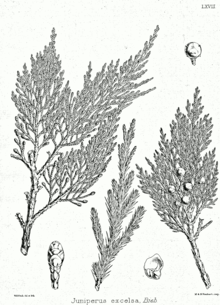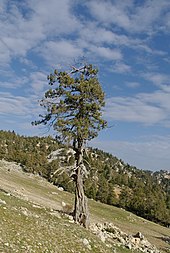Juniperus excelsa
| Juniperus excelsa | |
|---|---|

| |
| J. excelsa subsp. polycarpos[1] | |
| Scientific classification | |
| Kingdom: | Plantae |
| Clade: | Tracheophytes |
| Clade: | Gymnospermae |
| Division: | Pinophyta |
| Class: | Pinopsida |
| Order: | Cupressales
|
| Family: | Cupressaceae |
| Genus: | Juniperus |
| Section: | Juniperus sect. Sabina
|
| Species: | J. excelsa
|
| Binomial name | |
| Juniperus excelsa | |

| |
| Distribution of Juniperus excelsa complex | |
Juniperus excelsa, commonly called the Greek juniper, is a juniper found throughout the eastern Mediterranean, from northeastern Greece and southern Bulgaria across Turkey to Syria and Lebanon, Jordan, the Caucasus mountains, and southern coast of Crimea.
A subspecies, J. excelsa subsp. polycarpos, known as the Persian juniper, occurs in the Alborz and other mountains of Iran east to northwestern Pakistan, and an isolated population in the Jebal Akhdar mountains of Oman; some botanists treat this as a distinct species, Juniperus polycarpos.[3]
Description

Juniperus excelsa is a large
It is largely
It often occurs together with Juniperus foetidissima, being distinguished from it by its slenderer shoots 0.7–1.3 mm diameter (1.2–2 mm diameter in J. foetidissima), and grey-green, rather than mid green, leaves.
The Algum wood mentioned in the Bible may be from this species, but is not definitely so.
Gallery
-
Juniperus excelsa specimen in Tisata reserve in southwestern Bulgaria
-
Juniperus excelsa habitat in Tisata reserve
References
- Farjon, A. (2013). "Juniperus excelsa". . Retrieved 12 November 2021.
- Adams, R. P. (2004). Junipers of the World: The genus Juniperus. Victoria: Trafford. ISBN 1-4120-4250-X.
- Farjon, A. (2005). Monograph of Cupressaceae and Sciadopitys. Royal Botanic Gardens, Kew. ISBN 1-84246-068-4.
- Earle, Christopher J., ed. (2018). "Juniperus excelsa". The Gymnosperm Database.
- photo of tree in southwest Turkey
External links
![]() Media related to Juniperus excelsa at Wikimedia Commons
Media related to Juniperus excelsa at Wikimedia Commons
- Juniperus excelsa - information, genetic conservation units and related resources. European Forest Genetic Resources Programme (EUFORGEN)



